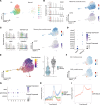Tertiary lymphoid structures sustain cutaneous B cell activity in hidradenitis suppurativa
- PMID: 38113104
- PMCID: PMC10967391
- DOI: 10.1172/jci.insight.169870
Tertiary lymphoid structures sustain cutaneous B cell activity in hidradenitis suppurativa
Abstract
Hidradenitis suppurativa (HS) is a chronic skin condition affecting approximately 1% of the US population. HS skin lesions are highly inflammatory and characterized by a large immune infiltrate. While B cells and plasma cells comprise a major component of this immune milieu, the biology and the contribution of these cells in HS pathogenesis are unclear. We aimed to investigate the dynamics and microenvironmental interactions of B cells within cutaneous HS lesions. Combining histological analysis, single-cell RNA sequencing, and spatial transcriptomics profiling of HS lesions, we defined the tissue microenvironment relative to B cell activity within this disease. Our findings identified tertiary lymphoid structures (TLSs) within HS lesions and described organized interactions among T cells, B cells, antigen-presenting cells, and skin stroma. We found evidence that B cells within HS TLSs actively underwent maturation, including participation in germinal center reactions and class switch recombination. Moreover, skin stroma and accumulating T cells were primed to support the formation of TLSs and facilitate B cell recruitment during HS. Our data definitively demonstrated the presence of TLSs in lesional HS skin and point to ongoing cutaneous B cell maturation through class switch recombination and affinity maturation during disease progression in this inflamed nonlymphoid tissue.
Keywords: Adaptive immunity; Dermatology; Immunology; Skin.
Figures





Update of
-
Tertiary Lymphoid Structures Sustain Cutaneous B cell Activity in Hidradenitis Suppurativa.bioRxiv [Preprint]. 2023 Feb 15:2023.02.14.528504. doi: 10.1101/2023.02.14.528504. bioRxiv. 2023. Update in: JCI Insight. 2024 Feb 8;9(3):e169870. doi: 10.1172/jci.insight.169870. PMID: 36824918 Free PMC article. Updated. Preprint.
References
Publication types
MeSH terms
Grants and funding
LinkOut - more resources
Full Text Sources
Medical
Molecular Biology Databases

